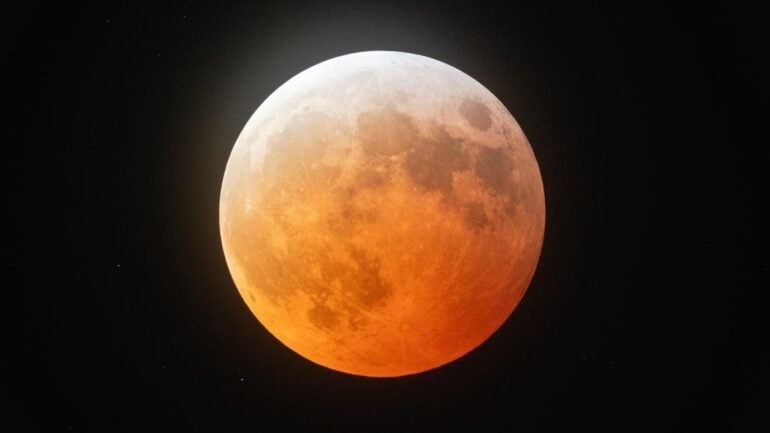Topline
Skywatchers in North America will get a special sight on Sunday, Sept. 7, 20205, when the final full moon of summer in the Northern Hemisphere — the corn moon — rises in the east during dusk. For observers in Australia, Asia, Africa and parts of Europe, the rise of the full moon will be followed by its journey through Earth’s shadow in space, with its surface glowing reddish-orange for 82 minutes.
A ‘Blood Worm Moon’ total lunar eclipse is seen above Austin, TX on March 14, 2025. (Photo by Rick Kern/Getty Images)
Getty Images
Key Facts
The full corn moon occurs on Sunday, Sept. 7, 2025, turning full at 2:10 p.m. EDT. That’s when the night side of the world will see a total lunar eclipse, which will be streamed live on YouTube.
From North America, the full moon will be seen rising in the east during dusk, hours after the eclipse is over.
The times of the full moonrise in North America vary by city, but in New York, the moon rises at 7:22 p.m. EDT, and in Los Angeles, at 7:19 p.m. PDT. Check the exact time of moonrise where you are, which will occur just after sunset. A clear eastern horizon is essential to watch a moonrise.
In regions where the total lunar eclipse is visible, totality will last 82 minutes, though the entire eclipse stretches over about five hours.
A rising full moon is entirely safe to watch with the naked eye, as are all kinds of lunar eclipses. That’s unlike a solar eclipse, which requires solar eclipse glasses and solar filters on binoculars, telescopes and cameras.
Why Some See Red And Some Don’t
A lunar eclipse is a global event happening at the same time everywhere, but it’s only visible from the night side of Earth. While North America will be on the day side during the eclipse, observers in regions including the Middle East, Asia and Australia will watch the moon turn red. For North Americans, the corn moon will look “normal” — an orangey disk rising at dusk.
The Next Big Eclipse For The Americas
The next total lunar eclipse visible across North America will arrive on March 2-3, 2026. That one will also bring a blood moon lasting nearly an hour. Between now and then, a partial solar eclipse will occur for 18 countries in the Southern Hemisphere, with New Zealand, the western South Pacific and Antarctica seeing up to an 85% eclipse at sunrise on Sept. 21-22, 2025.
